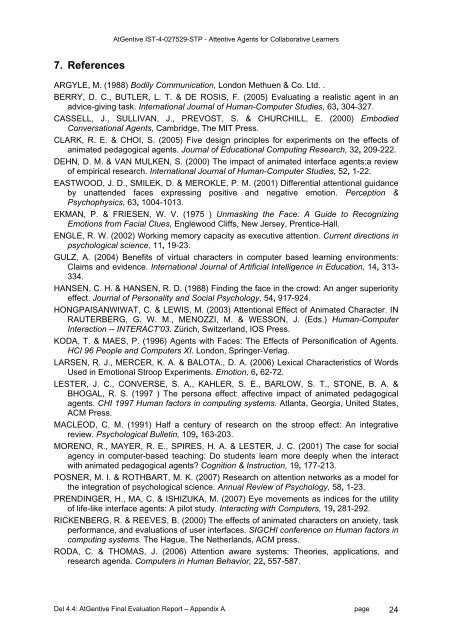Deliverable 4.4 - INSEAD CALT
Deliverable 4.4 - INSEAD CALT
Deliverable 4.4 - INSEAD CALT
Create successful ePaper yourself
Turn your PDF publications into a flip-book with our unique Google optimized e-Paper software.
AtGentive IST-4-027529-STP - Attentive Agents for Collaborative Learners7. ReferencesARGYLE, M. (1988) Bodily Communication, London Methuen & Co. Ltd. .BERRY, D. C., BUTLER, L. T. & DE ROSIS, F. (2005) Evaluating a realistic agent in anadvice-giving task. International Journal of Human-Computer Studies, 63, 304-327.CASSELL, J., SULLIVAN, J., PREVOST, S. & CHURCHILL, E. (2000) EmbodiedConversational Agents, Cambridge, The MIT Press.CLARK, R. E. & CHOI, S. (2005) Five design principles for experiments on the effects ofanimated pedagogical agents. Journal of Educational Computing Research, 32, 209-222.DEHN, D. M. & VAN MULKEN, S. (2000) The impact of animated interface agents:a reviewof empirical research. International Journal of Human-Computer Studies, 52, 1-22.EASTWOOD, J. D., SMILEK, D. & MEROKLE, P. M. (2001) Differential attentional guidanceby unattended faces expressing positive and negative emotion. Perception &Psychophysics, 63, 1004-1013.EKMAN, P. & FRIESEN, W. V. (1975 ) Unmasking the Face: A Guide to RecognizingEmotions from Facial Clues, Englewood Cliffs, New Jersey, Prentice-Hall.ENGLE, R. W. (2002) Working memory capacity as executive attention. Current directions inpsychological science, 11, 19-23.GULZ, A. (2004) Benefits of virtual characters in computer based learning environments:Claims and evidence. International Journal of Artificial Intelligence in Education, 14, 313-334.HANSEN, C. H. & HANSEN, R. D. (1988) Finding the face in the crowd: An anger superiorityeffect. Journal of Personality and Social Psychology, 54, 917-924.HONGPAISANWIWAT, C. & LEWIS, M. (2003) Attentional Effect of Animated Character. INRAUTERBERG, G. W. M., MENOZZI, M. & WESSON, J. (Eds.) Human-ComputerInteraction -- INTERACT'03. Zürich, Switzerland, IOS Press.KODA, T. & MAES, P. (1996) Agents with Faces: The Effects of Personification of Agents.HCI 96 People and Computers XI. London, Springer-Verlag.LARSEN, R. J., MERCER, K. A. & BALOTA., D. A. (2006) Lexical Characteristics of WordsUsed in Emotional Stroop Experiments. Emotion, 6, 62-72.LESTER, J. C., CONVERSE, S. A., KAHLER, S. E., BARLOW, S. T., STONE, B. A. &BHOGAL, R. S. (1997 ) The persona effect: affective impact of animated pedagogicalagents. CHI 1997 Human factors in computing systems. Atlanta, Georgia, United States,ACM Press.MACLEOD, C. M. (1991) Half a century of research on the stroop effect: An integrativereview. Psychological Bulletin, 109, 163-203.MORENO, R., MAYER, R. E., SPIRES, H. A. & LESTER, J. C. (2001) The case for socialagency in computer-based teaching: Do students learn more deeply when the interactwith animated pedagogical agents? Cognition & Instruction, 19, 177-213.POSNER, M. I. & ROTHBART, M. K. (2007) Research on attention networks as a model forthe integration of psychological science. Annual Review of Psychology, 58, 1-23.PRENDINGER, H., MA, C. & ISHIZUKA, M. (2007) Eye movements as indices for the utilityof life-like interface agents: A pilot study. Interacting with Computers, 19, 281-292.RICKENBERG, R. & REEVES, B. (2000) The effects of animated characters on anxiety, taskperformance, and evaluations of user interfaces. SIGCHI conference on Human factors incomputing systems. The Hague, The Netherlands, ACM press.RODA, C. & THOMAS, J. (2006) Attention aware systems: Theories, applications, andresearch agenda. Computers in Human Behavior, 22, 557-587.Del <strong>4.4</strong>: AtGentive Final Evaluation Report – Appendix A page 24
















